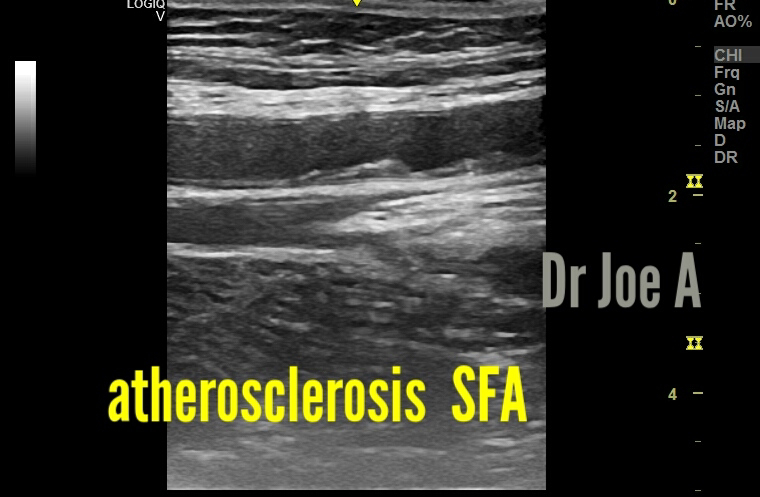Despite the extensive calcifications and atherosclerosis of the arteries including the CFA, SFA and popliteal arteries, there was no significant stenosis of these vessels.
Final diagnosis: extensive early calcific atherosclerosis of lower limb arteries. Insignificant stenosis of major arteries.
Calcific Atherosclerosis of the Lower Limbs in Elderly Males
- Calcific atherosclerosis is a common condition that affects the arteries of the lower limbs in elderly males.
- It is characterized by the deposition of calcium in the arterial walls, which can lead to narrowing of the arteries and decreased blood flow.
- This can cause symptoms such as pain, numbness, and weakness in the legs.
- The most common symptom of calcific atherosclerosis is claudication, which is pain in the legs that occurs when walking.
- The pain is caused by decreased blood flow to the muscles of the legs.
- The pain typically goes away after resting.
- In the case of calcific atherosclerosis, ultrasound will typically show areas of increased echogenicity and calcification within the arterial walls.
- Color Doppler imaging may also show decreased blood flow in the affected areas. In this case, no significant stenosis seen in the major vessels.
- There is no cure for calcific atherosclerosis, but there are treatments that can help to improve symptoms and prevent complications.
- These treatments may include:
- Lifestyle changes, such as exercise, smoking cessation, and a healthy diet
- Medications, such as aspirin, clopidogrel, and statins
- Endovascular procedures, such as angioplasty and stenting
- Surgery, such as bypass grafting
A Case Study
An elderly male patient presented to the doctor with pain and claudication in his legs.
- The patient had a history of smoking and hypertension.
- An ultrasound and color Doppler imaging of the patient's lower limbs arteries showed calcific atherosclerosis.
- The color Doppler imaging showed no significant flow changes in the affected areas. Thus, normal flow was seen.
- The patient was started on a treatment regimen that included lifestyle changes, medications, and endovascular procedures.
- The patient's symptoms improved significantly after treatment.
Prognosis in this patient:
The prognosis for early calcific atherosclerosis of lower limb arteries without significant stenosis is generally good. In most cases, the condition does not cause any symptoms and does not progress to significant narrowing of the arteries. However, there is a risk that the condition could worsen over time, leading to claudication (pain in the legs when walking) or even limb amputation.
There are a number of things that can be done to reduce the risk of progression of early calcific atherosclerosis, including:
* Maintaining a healthy weight
* Eating a healthy diet
* Exercising regularly
* Not smoking
* Controlling blood pressure and cholesterol levels.
* It is a condition in which calcium deposits build up in the walls of the arteries in the legs.
* The deposits can narrow the arteries and reduce blood flow to the legs.
* This can cause symptoms such as pain, numbness, and weakness in the legs.
* The condition is more common in people who are older, have diabetes, or smoke.
* There is no cure for early calcific atherosclerosis, but there are treatments that can help to slow the progression of the disease and prevent complications.
Conclusion
Calcific atherosclerosis is a common condition that can cause significant symptoms and complications.
- However, there are treatments that can help to improve symptoms and prevent complications.
For more on this topic visit:







No comments:
Post a Comment